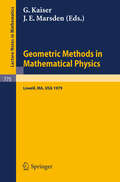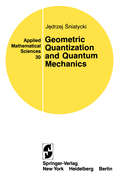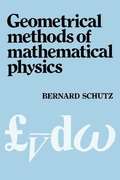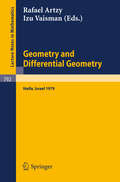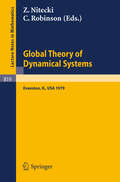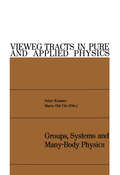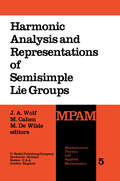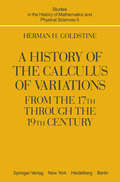- Table View
- List View
Generators and Relations for Discrete Groups (Ergebnisse der Mathematik und ihrer Grenzgebiete. 2. Folge #14)
by Harold S.M. Coxeter William O. MoserWhen we began to consider the scope of this book, we envisaged a catalogue supplying at least one abstract definition for any finitely generated group that the reader might propose. But we soon realized that more or less arbitrary restrictions are necessary, because interesting groups are so numerous. For permutation groups of degree 8 or less (i.e.' .subgroups of es), the reader cannot do better than consult the tables of JosEPHINE BuRNS (1915), while keeping an eye open for misprints. Our own tables (on pages 134-142) deal with groups of low order, finite and infinite groups of congruent transformations, symmetric and alternating groups, linear fractional groups, and groups generated by reflections in real Euclidean space of any number of dimensions. The best substitute for a more extensive catalogue is the description (in Chapter 2) of a method whereby the reader can easily work out his own abstract definition for almost any given finite group. This method is sufficiently mechanical for the use of an electronic computer.
Geometric Methods in Mathematical Physics: Proceedings of an NSF-CBMS Conference Held at the University of Lowell, Massachusetts, March 19-23, 1979 (Lecture Notes in Mathematics #775)
by G. Kaiser J. E. MarsdenGeometric Quantization and Quantum Mechanics (Applied Mathematical Sciences #30)
by Jedrzej SniatyckiThis book contains a revised and expanded version of the lecture notes of two seminar series given during the academic year 1976/77 at the Department of Mathematics and Statistics of the University of Calgary, and in the summer of 1978 at the Institute of Theoretical Physics of the Technical University Clausthal. The aim of the seminars was to present geometric quantization from the point of view· of its applica tions to quantum mechanics, and to introduce the quantum dynamics of various physical systems as the result of the geometric quantization of the classical dynamics of these systems. The group representation aspects of geometric quantiza tion as well as proofs of the existence and the uniqueness of the introduced structures can be found in the expository papers of Blattner, Kostant, Sternberg and Wolf, and also in the references quoted in these papers. The books of Souriau (1970) and Simms and Woodhouse (1976) present the theory of geometric quantization and its relationship to quantum mech anics. The purpose of the present book is to complement the preceding ones by including new developments of the theory and emphasizing the computations leading to results in quantum mechanics.
Geometrical Approaches to Differential Equations: Proceedings of the Fourth Scheveningen Conference on Differential Equations, The Netherlands, August 26-31, 1979 (Lecture Notes in Mathematics #810)
by R. MartiniGeometrical Methods for the Theory of Linear Systems: Proceedings of a NATO Advanced Study Institute and AMS Summer Seminar in Applied Mathematics held at Harvard University, Cambridge, Mass., June 18–29, 1979 (Nato Science Series C: #62)
by C. I. Byrnes C. F. MartinThe lectures contained in this book were presented at Harvard University in June 1979. The workshop at which they were presented was the third such on algebro-geometric methods. The first was held in 1973 in London and the emphasis was largely on geometric methods. The second was held at Ames Research Center-NASA in 1976. There again the emphasis was on geometric methods, but algebraic geometry was becoming a dominant theme. In the two years after the Ames meeting there was tremendous growth in the applications of algebraic geometry to systems theory and it was becoming clear that much of the algebraic systems theory was very closely related to the geometric systems theory. On this basis we felt that this was the right time to devote a workshop to the applications of algebra and algebraic geometry to linear systems theory. The lectures contained in this volume represent all but one of the tutorial lectures presented at the workshop. The lec ture of Professor Murray Wonham is not contained in this volume and we refer the interested to the archival literature. This workshop was jointly sponsored by a grant from Ames Research Center-NASA and a grant from the Advanced Study Institute Program of NATO. We greatly appreciate the financial support rendered by these two organizations. The American Mathematical Society hosted this meeting as part of their Summer Seminars in Applied Mathematics and will publish the companion volume of con tributed papers.
Geometrical Methods of Mathematical Physics (PDF)
by Bernard F. SchutzIn recent years the methods of modern differential geometry have become of considerable importance in theoretical physics and have found application in relativity and cosmology, high-energy physics and field theory, thermodynamics, fluid dynamics and mechanics. This textbook provides an introduction to these methods - in particular Lie derivatives, Lie groups and differential forms - and covers their extensive applications to theoretical physics. The reader is assumed to have some familiarity with advanced calculus, linear algebra and a little elementary operator theory. The advanced physics undergraduate should therefore find the presentation quite accessible. This account will prove valuable for those with backgrounds in physics and applied mathematics who desire an introduction to the subject. Having studied the book, the reader will be able to comprehend research papers that use this mathematics and follow more advanced pure-mathematical expositions.
Geometry and Differential Geometry: Proceedings of a Conference Held at the University of Haifa, Israel, March 18-23, 1979 (Lecture Notes in Mathematics #792)
by R. Artzy I. VaismanThe Geometry of Biological Time (Springer Study Edition Ser.)
by Arthur T. WinfreeAs 1 review these pages, the last of them written in Summer 1978, some retrospec tive thoughts come to mind which put the whole business into better perspective for me and might aid the prospective reader in choosing how to approach this volume. The most conspicuous thought in my mind at present is the diversity of wholly independent explorations that came upon phase singularities, in one guise or another, during the past decade. My efforts to gather the published literature during the last phases of actually writing a whole book about them were almost equally divided between libraries of Biology, Chemistry, Engineering, Mathematics, Medicine, and Physics. A lot of what 1 call "gathering " was done somewhat in anticipation in the form of cönjecture, query, and prediction based on analogy between developments in different fields. The consequence throughout 1979 was that our long-suffering publisher re peatedly had to replace such material by citation of unexpected flurries of papers giving substantive demonstration. 1 trust that the authors of these many excellent reports, and especially of those I only found too late, will forgive the brevity of allusion I feIt compelled to observe in these substitutions. A residue of loose ends is largely collected in the index under "QUERIES. " It is c1ear to me already that the materials I began to gather several years ago represented only the first flickering of what turns out to be a substantial conflagration.
Global Theory of Dynamical Systems: Proceedings of an International Conference Held at Northwestern University, Evanston, Illinois, June 18-22, 1979 (Lecture Notes in Mathematics #819)
by Z. Nitecki C. RobinsonGroße mathematische Formelsammlung: Mathematische und naturwissenschaftliche Tafeln
by Friedrich KemnitzGroups, Systems and Many-Body Physics (Vieweg tracts in pure and applied physics #4)
by Peter Dal CinThe authors of the present book share the view that groups and semigroups playa funda mental role in the structure of the complex systems which they are studying. A serious effort was made to implement this point of view by presenting the fundamental concepts pertaining to groups and semigroups before going into the various fields of application. The first two chapters are written in this spirit. The following seven chapters deal with groups in relation to specific systems and lead from basic notions to high-level applications. The systems under study are in all cases characterized by a high degree of complexity as found in the physics of many degrees of freedom and in the theory of automata and systems. In 1977 the authors from the University of Tiibingen (M. Dal Cin, G. John, P. Kramer, A. Rieckers, K. Scheerer and H. Stumpf) organized an International Summer School on Groups and Many-Body Physics. The lectures presented at this School dealt specifically with this interplay of groups and complex systems. The contributions of this book cover the fields which were treated in a condensed form at the Summer School.
Harmonic Analysis 1978: Proceedings of a Conference Held at the University of Crete, Iraklion, Greece, July 1978 (Lecture Notes in Mathematics #781)
by N. Petridis S. K. Pichorides N. VaropoulosHarmonic Analysis and Representations of Semisimple Lie Groups: Lectures given at the NATO Advanced Study Institute on Representations of Lie Groups and Harmonic Analysis, held at Liège, Belgium, September 5–17, 1977 (Mathematical Physics and Applied Mathematics #5)
by J. A. Wolf M. Cahen M. De WildeThis book presents the text of the lectures which were given at the NATO Advanced Study Institute on Representations of Lie groups and Harmonic Analysis which was held in Liege from September 5 to September 17, 1977. The general aim of this Summer School was to give a coordinated intro duction to the theory of representations of semisimple Lie groups and to non-commutative harmonic analysis on these groups, together with some glance at physical applications and at the related subject of random walks. As will appear to the reader, the order of the papers - which follows relatively closely the order of the lectures which were actually give- follows a logical pattern. The two first papers are introductory: the one by R. Blattner describes in a very progressive way a path going from standard Fourier analysis on IR" to non-commutative harmonic analysis on a locally compact group; the paper by J. Wolf describes the structure of semisimple Lie groups, the finite-dimensional representations of these groups and introduces basic facts about infinite-dimensional unitary representations. Two of the editors want to thank particularly these two lecturers who were very careful to pave the way for the later lectures. Both these chapters give also very useful guidelines to the relevant literature.
A History of the Calculus of Variations from the 17th through the 19th Century (Studies in the History of Mathematics and Physical Sciences #5)
by H. H. GoldstineThe calculus of variations is a subject whose beginning can be precisely dated. It might be said to begin at the moment that Euler coined the name calculus of variations but this is, of course, not the true moment of inception of the subject. It would not have been unreasonable if I had gone back to the set of isoperimetric problems considered by Greek mathemati cians such as Zenodorus (c. 200 B. C. ) and preserved by Pappus (c. 300 A. D. ). I have not done this since these problems were solved by geometric means. Instead I have arbitrarily chosen to begin with Fermat's elegant principle of least time. He used this principle in 1662 to show how a light ray was refracted at the interface between two optical media of different densities. This analysis of Fermat seems to me especially appropriate as a starting point: He used the methods of the calculus to minimize the time of passage cif a light ray through the two media, and his method was adapted by John Bernoulli to solve the brachystochrone problem. There have been several other histories of the subject, but they are now hopelessly archaic. One by Robert Woodhouse appeared in 1810 and another by Isaac Todhunter in 1861.
Independence Theory in Combinatorics: An Introductory Account with Applications to Graphs and Transversals
by V. BryantCombinatorics may very loosely be described as that branch of mathematics which is concerned with the problems of arranging objects in accordance with various imposed constraints. It covers a wide range of ideas and because of its fundamental nature it has applications throughout mathematics. Among the well-established areas of combinatorics may now be included the studies of graphs and networks, block designs, games, transversals, and enumeration problem s concerning permutations and combinations, from which the subject earned its title, as weil as the theory of independence spaces (or matroids). Along this broad front,various central themes link together the very diverse ideas. The theme which we introduce in this book is that of the abstract concept of independence. Here the reason for the abstraction is to unify; and, as we sh all see, this unification pays off handsomely with applications and illuminating sidelights in a wide variety of combinatorial situations. The study of combinatorics in general, and independence theory in particular, accounts for a considerable amount of space in the mathematical journais. For the most part, however, the books on abstract independence so far written are at an advanced level, ·whereas the purpose of our short book is to provide an elementary in troduction to the subject.
Introduction to Multivariate Analysis
by C. Chatfied A. J. CollinsThis book provides an introduction to the analysis of multivariate data. It should be suitable for statisticians and other research workers who are familiar with basic probability theory and elementary inference, and also have a basic grounding in matrix algebra. The book should also be suitable as a text for undergraduate and postgraduate statistics courses on multivariate analysis. The book covers a wider range oftopics than some other books in this area. It deals with preliminary data analysis, principal component and factor analysis and traditional normal-theory material. It also covers cluster analysis and scaling techniques. In writing the book, we have tried to provide a reasonable blend of theory and practice, in contrast to much of the existing literature which concentrates on one or other aspect. Enough theory is given to introduce the concepts and to make the topics mathematically interesting. But we also discuss the use (and misuse) of the techniques in practice and present appropriate real-life examples. Although the book is primarily an introductory text, we have nevertheless added appropriate references for further reading, so that the reader may extend his studies if he wishes.
Introduction to Numerical Analysis
by J. Stoer R. BulirschThis book is based on a one-year introductory course on numerical analysis given by the authors at several universities in Germany and the United States. The authors concentrate on methods which can be worked out on a digital computer. For important topics, algorithmic descriptions (given more or less formally in ALGOL 60), as well as thorough but concise treatments of their theoretical founda tions, are provided. Where several methods for solving a problem are presented, comparisons of their applicability and limitations are offered. Each comparison is based on operation counts, theoretical properties such as convergence rates, and, more importantly, the intrinsic numerical properties that account for the reliability or unreliability of an algorithm. Within this context, the introductory chapter on error analysis plays a special role because it precisely describes basic concepts, such as the numerical stability of algorithms, that are indispensable in the thorough treatment of numerical questions. The remaining seven chapters are devoted to describing numerical methods in various contexts. In addition to covering standard topics, these chapters encom pass some special subjects not usually found in introductions to numerical analysis. Chapter 2, which discusses interpolation, gives an account of modem fast Fourier transform methods. In Chapter 3, extrapolation techniques for spe~d ing up the convergence of discretization methods in connection with Romberg integration are explained at length.
Introduction to Pseudodifferential and Fourier Integral Operators: Pseudodifferential Operators (University Series in Mathematics)
by Jean-François TrevesI have tried in this book to describe those aspects of pseudodifferential and Fourier integral operator theory whose usefulness seems proven and which, from the viewpoint of organization and "presentability," appear to have stabilized. Since, in my opinion, the main justification for studying these operators is pragmatic, much attention has been paid to explaining their handling and to giving examples of their use. Thus the theoretical chapters usually begin with a section in which the construction of special solutions of linear partial differential equations is carried out, constructions from which the subsequent theory has emerged and which continue to motivate it: parametrices of elliptic equations in Chapter I (introducing pseudodifferen tial operators of type 1, 0, which here are called standard), of hypoelliptic equations in Chapter IV (devoted to pseudodifferential operators of type p, 8), fundamental solutions of strongly hyperbolic Cauchy problems in Chap ter VI (which introduces, from a "naive" standpoint, Fourier integral operators), and of certain nonhyperbolic forward Cauchy problems in Chapter X (Fourier integral operators with complex phase). Several chapters-II, III, IX, XI, and XII-are devoted entirely to applications. Chapter II provides all the facts about pseudodifferential operators needed in the proof of the Atiyah-Singer index theorem, then goes on to present part of the results of A. Calderon on uniqueness in the Cauchy problem, and ends with a new proof (due to J. J. Kohn) of the celebrated sum-of-squares theorem of L. Hormander, a proof that beautifully demon strates the advantages of using pseudodifferential operators.


